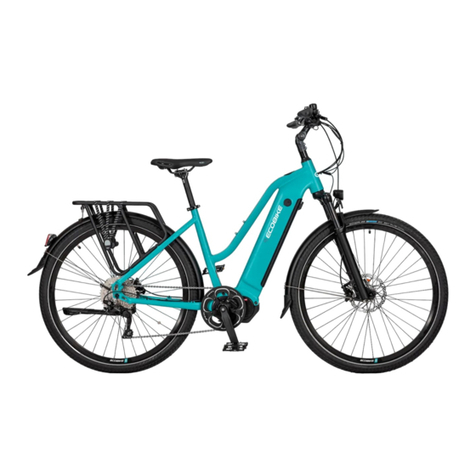Ecobike SX 300 Blue 18" User guide

1

2

3
SPIS TREŚCI
1. INTRODUCE .............................................................................................................................................5
2. SAFETY......................................................................................................................................................5
2.1 FOR PARENTS / GUARDIANS .............................................................................................................5
3. USE ACCORDING TO THE INTENDING....................................................................................................6
3.1 MOUNTAIN BIKE .................................................................................................................................6
3.2 CENTRAL MOTOR ..............................................................................................................................6
4. STORAGE AND USING.............................................................................................................................6
5. BEFORE RIDDING.....................................................................................................................................6
6. TECHNICAL INFORMATION.....................................................................................................................7
6.1 RIMS....................................................................................................................................................7
6.2 SADDLE ..............................................................................................................................................7
6.3 BEARINGS OF HANDLEBAR ...............................................................................................................7
6.4 WHEELS...............................................................................................................................................8
6.5 TIRES ...................................................................................................................................................8
6.6 SPOKES...............................................................................................................................................8
6.7 BRAKES ...............................................................................................................................................8
6.8 CRANKSET ..........................................................................................................................................8
6.9 PEDALS...............................................................................................................................................8
6.10 DERAILLEUR ......................................................................................................................................9
6.11 CHAIN ..............................................................................................................................................9
6.12 TROLLEY............................................................................................................................................9
6.13 RACK (OPTION) ...............................................................................................................................9
6.14 LIGHTING..........................................................................................................................................9
7. ASSMBLY..................................................................................................................................................9
7.1 PREPARING ........................................................................................................................................9
7.2 FOLD THE FRAME .............................................................................................................................10
7.3 HANDLEBAR ASSEMBLY ...................................................................................................................10
7.4 PEDALS ASSEMBLY...........................................................................................................................10
7.5 SADDLE ASSEMBLY ..........................................................................................................................10
8. GREASE..................................................................................................................................................11
9. USING BATTERY AND CHARGER...........................................................................................................11
9.1 BATTERY............................................................................................................................................11
9.2 IMPORTANT INFORMATION ABOUT BATTERIES ...............................................................................11
9.3 INSERTION AND REMOVAL THE BATTERY........................................................................................12
10. CHARGING THE BATTERY....................................................................................................................12
11. user manual LCD C900 USB ..............................................................................................................12
11.1 DISPLAY APPEARANCE..................................................................................................................12

4
11.2 TURNING ON / OFF THE DISPLAY...................................................................................................12
11.3 MOTOR POWER INDICATION........................................................................................................13
11.4 battery soc indicator ....................................................................................................................13
11.5 WALK ASSISTANCE.........................................................................................................................13
11.6 backlight and light indication......................................................................................................13
11.7 motor assistance level selection..................................................................................................13
11.8 error indication..............................................................................................................................13
The display cannot return to normal until the problem is resolved. The e-bike will not work until
the problem is resolved. .......................................................................................................................13
11.9 CURRENT DISPLAY..........................................................................................................................14
12. MAIN MENU – USER SETTINGS .............................................................................................................14
12.1 enter the settings menu................................................................................................................14
12.2 resetting the trip distance ............................................................................................................14
12.3 UNIT SETTING ..................................................................................................................................14
12.4 wheel size setting ..........................................................................................................................14
12.5 LCD luminance .............................................................................................................................15
12.6 acceleration power......................................................................................................................15
13. Main menu – advanced settings ......................................................................................................15
13.1 enter the advanced settings menu ............................................................................................15
13.2 electric assistance level range ....................................................................................................15
13.3 voltage setting ..............................................................................................................................15
12. WARRANTY CARD...............................................................................................................................16
13. NOTES ..................................................................................................................................................17

5
1. INTRODUCE
First of all, we would like to thank you for purchasing our electric bike, which has been
carefully designed and manufactured in accordance with the requirements of the highest
international standards. We wish your new bike to be a new way of your life.
Please read the following instructions carefully before proceeding with the bicycle. The
manual contains important information related to the safety, operation and assembly of
the bicycle. The bike has electrical parts which, according to the Act, are considered
dangerous, which means the obligation to dispose of - it cannot be disposed of in standard
garbage. Please remember that it’s offence.
2. SAFETY
•We suggest using the appropriate helmet in accordance with the European
standards.
•Observe the traffic regulations.
•We recommend that you take extra care when moving with crowded traffic.
•Perform a bicycle service only at bicycle service points.
•Regular service will provide you with a greater safety of bicycle use and prolong its
life.
•Carry out regular maintenance according to the instructions.
•Do not make any repairs to electrical parts yourself, only at designated service points.
•Never ride a bicycle if you have drunk or taken other intoxicants.
•The user should have front and rear lights and reflectors on the wheels.
•When cleaning the bicycle, always use soft wiper.
•Hold the steering wheel with both hands while ridding.
•Do not catch or other vehicles.
•Avoid sudden braking.
•Do not wear loose clothing for cycling.
•Only use original spare parts for components.
•When installing bicycle accessories, it is recommended that you use these
accessories for assembly instructions.
•Parents should pay special attention to the safety of children while they are being
transported.
•Children should be transported in special chairs permanently attached to the
bicycle.
2.1 FOR PARENTS / GUARDIANS
Parents / guardians are responsible for the conduct and safety of their child. Before ridding
by a child, they should instruct them about the proper use of the bicycle. Before allowing
a child to ride, parents are required to:
Read the entire manual, and to familiarize the child with the warnings and functions
and principles of the bicycle.
Make sure that the child has an approved bicycle helmet when driving, and that he
understands all safety rules.
This manual suits for next models
9
Table of contents
Other Ecobike Scooter manuals


















